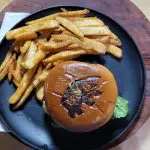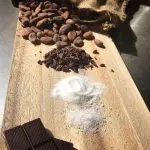Alaskan Cuisine & Culture: A Brief History
Humans have been inhabiting Alaska, the ‘Land of the Midnight Sun’, since at least 10,000 BCE, a time during which a land mass (the Bering Land Bridge) connected Siberia to North America where Alaska is today. Nomadic groups followed animal herds across this land mass and settled in different parts of the state. These groups lived by fishing, hunting, harvesting and foraging the vast Alaskan terrain.
Descendents of some of the earliest groups of settlers are still present in Alaska and though they consist of distinct and separate peoples, we collectively refer to these groups as Alaska Natives and they make up nearly 20% of the state’s population, more than any other state. With such a significant Alaskan Native population and many living in isolated rural areas, many of their traditional food dishes and preparations are still eaten in those communities. Though you may not see Muktuk (raw whale skin and blubber) or Akutaq (the Alaskan Athabaskans version of ice cream made with whipped fat mixed with meat or fish and berries) on most restaurant menus in Alaska, the modern local Alaskan diet does share things in common with the food that has been feeding the people of Alaska for centuries – particularly the central role of regionally-sourced fish and seafood, an affinity for wild game meat and foraging for wild berries.
In 1896, gold was found in Alaska and just three years later, copper was discovered. Tens of thousands of people migrated to the state in pursuit of this new opportunity, bringing with them different ingredients and palates. At this time, baking soda and yeast had become standard leavening agents for making bread in cities, where they could conveniently be purchased at the store and kept in the pantry.
However, in Alaska, where supplies weren’t so easily shipped and many residents were living in mining camps without the amenities of a full kitchen, sourdough became a staple of the Alaskan miner’s diet. Where other ingredients were heavy to carry around or simply weren’t available, keeping a sourdough starter required just a bit of flour, water and somewhere warm to keep it. It’s said that many miners would sleep with their sourdough starter or keep it on them in their shirt, just to ensure it maintained the proper temperature to ferment and be ready to use for their next batch of fresh bread. Since that time, bread, baked goods, and pancakes made with sourdough hold a special place in the hearts of Alaskans.
Mining continued to play a major role in Alaska’s culture and economy through the mid-century, and with it brought more infrastructure, people, industry, and appetites. In the early 1920s, the Alaska railroad was completed, running nearly 500 miles and connecting the state from Seward to Fairbanks. In 1935, as part of President Franklin D. Roosevelt’s New Deal relief program, approximately 200 families from the northern Midwest were invited to relocate to the fertile land of the Matanuska Valley, which is located around 35 miles north of Anchorage. This bold move by the innovative president increased access to fresh produce and dairy for local Alaskans and established Matanuska Valley as the agricultural center it is today. Now that same area is known for growing some of the physically largest produce in the country, thanks to the nearly 20 hours a day of sunlight received during the summer months.
Over the years, mining slowed down in Alaska, but the discovery of natural gas and oil in the later half of the 20th century created great economic growth and even today remains the state’s largest industry. Although there’s so much more fascinating facts and history that have influenced this great state, America’s Last Frontier, a common thread that ties these histories and people together, from the Alaskan Natives population to the miners of the turn of the century and the Midwestern homesteaders decades later, is their spirit of resourcefulness, hard work and connection to the land that sustains them.
As Alaska has gone through these economic ups and downs and adapted over the years, Alaskan cuisine has adapted and changed too. Even in the last 10 – 15 years, the food scene has become much more elevated as exposure to the internet and media pique local interest in new foods and flavors at the same time as older Alaskans in the food industry return from the lower 48 with a new culinary repertoire. Despite these changes, there are staples of Alaskan cuisine that have endured the tests of time and we don’t see them going anywhere anytime soon! So when traveling to Alaska, here are just a few of the Alaskan staples we consider a must-try if you have the opportunity:
Salmon
With more coastline than any other state (over 46,000 miles!) Alaskan wild-caught seafood is some of the best in the world. The most iconic Alaskan fish is the salmon and for good reason. With five different species available in Alaska, the state produces about 80% of the country’s wild-caught salmon. You’ll find salmon on the menu at most restaurants in Alaska. Enjoy this delicious high quality fish in a variety of ways – smoked, baked or broiled – Alaskan salmon won’t disappoint!
Reindeer Sausage
Reindeer, a domesticated version of caribou, were introduced to Alaska in the late 19th century by the US government, with the intention of providing another source of sustenance for the Alaskan Natives, who they felt relied too heavily on the hunting of seals, whales, and walruses for food. Today, there are about 18,000 reindeer in the state, and reindeer sausage is a uniquely Alaskan treat. Reindeer sausage is usually made with a mixture of reindeer meat, beef and pork and often served similar to a hot dog, from a stand or small shop. They can be topped with caramelized onions, mustard, ketchup or a special sauce. When you come to Alaska, you won’t want to miss this savory Alaskan delicacy.
Baked Goods
We mentioned the importance of sourdough in Alaska’s history, so it should come as no surprise that high-quality baked goods, both savory and sweet, are a popular treat for locals. In Alaska’s cities especially, and Anchorage in particular, you can find a variety of great bakeries to choose from. Before you head out for some epic hiking or wildlife watching in Alaska’s beautiful terrain, grab a treat from one of the local bakeries to go with your coffee in the morning and you won’t regret it.
There’s much more to learn (and taste!) of Alaskan cuisine, but the above is a good starting place. To learn more and to taste a variety of Alaskan foods from the best locally-owned and operated businesses, join us for one of our guided Downtown Anchorage Walking Food Tours!







